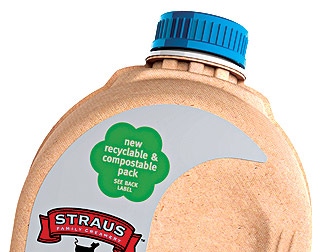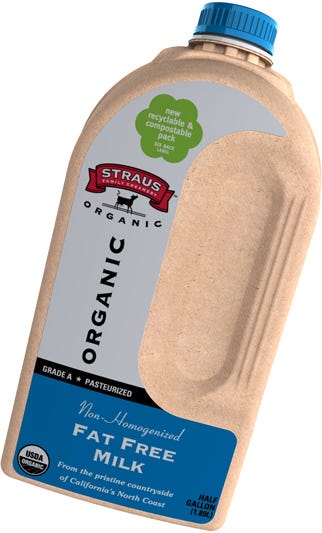January 30, 2014


Straus pouch-in-bottle test packaging
Straus Family Creamery, Marshall, CA, is currently market testing an eco-friendly, two-part paper bottle. The new package, which is supplied by Ecologic Brands Inc., builds upon earlier bag-in-box formats, with an outer shell that has no plastic coatings and made of 100-percent-recycled and recyclable paper that is compostable and biodegradable. The inner PE pouch is made with 70-percent less plastic than traditional milk jugs.As of January 2010, Straus Family Creamery has been using the Ecologic bottle to distribute one SKU—nonfat milk—at the Whole Foods' store in Oakland. Straus' primary packaging is a half-gal, returnable, reusable glass bottle.
Extending branding
“In principal, Ecologic is a bag-in-bottle with the consumer interface being almost identical to standard packaging,” says Julie Corbett, founder and CEO of Ecologic Brands, Inc. “The Ecologic bottle offers enhanced functionality [over bag-in-box formats] as it is easier to pour, hold and grip.”
The companies have been working on the bottle design, which aims to resemble Straus' trademark glass bottles, since March 2009,
Keeping it simple
While the bottle's structural design is very detailed in its replication of Straus' glass bottle, the Ecologic container's materials were purposely kept as close to their natural states as possible. “The bottle is designed to keep all the materials in their simple and natural forms so that they can be reconverted and remanufactured into something else,” says Corbett.
She adds that this further differentiates Ecologic bottles from other milk containers. “The current cardboard milk carton is a multi-laminated package where the materials are hard to separate from one another, which is why they are not recycled,” Corbett explains.
The same plastic—LDPE— is used for the closure as the lightweight interior pouch. In much the same way as a hybrid car integrates its gas- and electric-motor technologies for high performance. The LDPE pouch is designed to work in concert with the bottle's paper shell to protect milk as well as milk cartons or HDPE and glass bottles do.
Decorating, filling, coding
For this test, the bottle branding and nutritional information, as well as its UPC bar code, are displayed on an applied label. Ecologic says it is investigating direct-to-container printing options. Straus also is working on developing effective filling processes for the package, especially as it plans to expand the test to other San Francisco Bay Area stores after the 12-week test.
Expiration dates are coded onto the Ecologic bottles using a Domino A300 continuous ink-jet printer. Designed for coding in harsh environments, the A300 is housed in a 316-grade stainless-steel cabinet that is rated IP65. The coder also has a self-cleaning ink system with a large internal reservoir and nozzle seal. Electrically charged ink droplets are used to create high-quality characters based on a grid formation, which enables the printer to code a variety of substrates.
Planning wider adoption
Straus hopes that the Ecologic bottle will replace its HDPE bottles for retail stores that want to carry its organic milk but don't want to carry Straus' primary packaging. And Ecologic is looking closely at consumer adoption of the paper milk bottle. “Milk has the highest purchase frequency. It is important to understand repeat behavior versus novelty,” Corbett remarks. “The test will hopefully demonstrate that consumers are ready for better and more sustainable packaging choices.”
More information is available: |
Ecologic Brands Inc., 877/326-5642. www.ecologicbrands.com |
Domino Amjet Inc., 847/244-2501. www.dominoamjet.com |
About the Author(s)
You May Also Like


